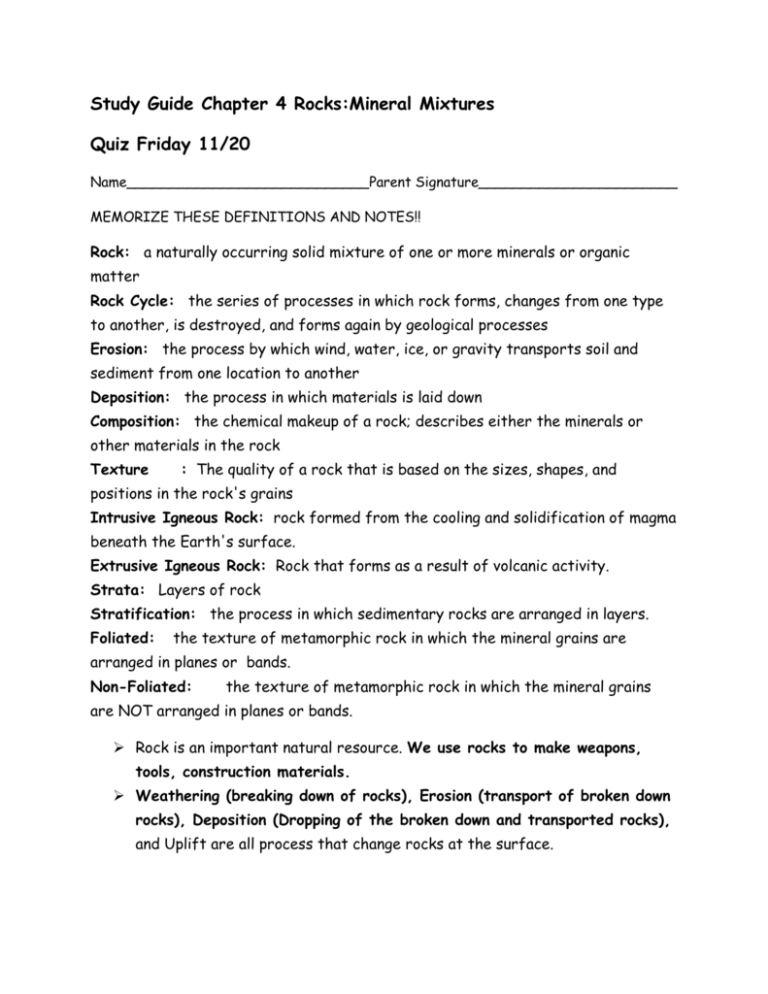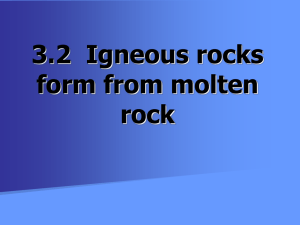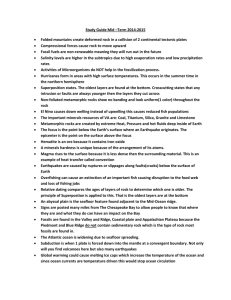Study-Guide-Chapter-4-Rocks
advertisement

Study Guide Chapter 4 Rocks:Mineral Mixtures Quiz Friday 11/20 Name____________________________Parent Signature_______________________ MEMORIZE THESE DEFINITIONS AND NOTES!! Rock: a naturally occurring solid mixture of one or more minerals or organic matter Rock Cycle: the series of processes in which rock forms, changes from one type to another, is destroyed, and forms again by geological processes Erosion: the process by which wind, water, ice, or gravity transports soil and sediment from one location to another Deposition: the process in which materials is laid down Composition: the chemical makeup of a rock; describes either the minerals or other materials in the rock Texture : The quality of a rock that is based on the sizes, shapes, and positions in the rock's grains Intrusive Igneous Rock: rock formed from the cooling and solidification of magma beneath the Earth's surface. Extrusive Igneous Rock: Rock that forms as a result of volcanic activity. Strata: Layers of rock Stratification: the process in which sedimentary rocks are arranged in layers. Foliated: the texture of metamorphic rock in which the mineral grains are arranged in planes or bands. Non-Foliated: the texture of metamorphic rock in which the mineral grains are NOT arranged in planes or bands. Rock is an important natural resource. We use rocks to make weapons, tools, construction materials. Weathering (breaking down of rocks), Erosion (transport of broken down rocks), Deposition (Dropping of the broken down and transported rocks), and Uplift are all process that change rocks at the surface. The sequence of the Rock cycle is weathering Erosion Deposition Pressure (Compaction & Cementation) Heating (Metamorphism ) Melting Cooling Rocks are classified by composition and texture. Composition is determined by the minerals that make up the rock Texture ranges from fine grained, medium grained, and course grained. Igneous rocks form from magma that cools and hardens, Texture of Igneous rocks is determined by the rate at which it cools. Two Types of Igneous Rocks o Intrusive Formed inside the earth and coarse grained because of longer cooling time. o Extrusive formed outside the earth and fine-grained because of shorter cooling time Shapes of common intrusive igneous bodies include batholiths, stocks, stills, and dikes. Sedimentary rocks form at or near the surface. Three Type of Sedimentary Rock o Clastic-cemented rock and mineral fragments o Chemical-crystalized minerals when mixed with other solutions o Organic-the remains of once-living plants and animals Sedimentary structures are ripple marks, mud cracks, and raindrop impressions. Metamorphic rocks are rocks in which the structure, texture has changed. Two ways rocks undergo metamorphism o Contact- near magma o Regional-near colliding crust or below other rock formation. During Metamorphisms, the original minerals change into new minerals that are more stable in the new temperature and pressure conditions. Two types of Textures of Metamorphic Rocks: o Foliated-aligned in planes and bands o Non-Foliated- NOT aligned with planes and bands Metamorphic rock structures are caused by deformation (bends and folds),









